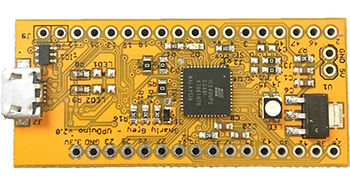Event:SoftwareDefinedRadioSDRFMDABontvangerworkshop: Difference between revisions
| Line 18: | Line 18: | ||
(have it preinstalled and git client to download the samplecode) | (have it preinstalled and git client to download the samplecode) | ||
== 3. Quick | == 3. Quick theory of signal processing == | ||
This could take about | This could take about one to or 1.5 hours | ||
Interactive session | |||
3.1 Real signals | == 3.1 Real signals == | ||
Real sinewaves | |||
In the timedomain | |||
Displayed using time sink / oscillioscope | |||
Displayed uisng frequency sink / FFT / spectrogram | |||
Multiplying real-sinewaves, in the time domain | |||
Displayed using time sink / oscillioscope | |||
Displayed uisng frequency sink / FFT / spectrogram | |||
Usage of the word 'mixing' in radioterms (multiplication or usage of other non-linearities) | |||
3. | == 3.2 Complex signals == | ||
Quadrature or complex (IQ) sinewave signal sources | |||
Displaying IQ signals in timedomain ('constellation' diagram) | |||
Displaying IQ signals in frequency domain (using FFT or frequency sinks) | |||
Multiplying quadrature (IQ) sinewaves and spectrogram | |||
Effect of quadrature multiplication (phases of are added) | |||
Usage of complex multiplication in signal processing | |||
3.4 Calculating FIR filter coefficients or parameters | == 3.3 Filtering complex signals == | ||
Filtering IQ signals using FIR filters with complex taps. FIR or Finite Impulse Response filters. IIR filters will be skipped. | |||
== 3.4 Calculating FIR filter coefficients or parameters == | |||
Filtering coefficients/taps, impulse response of filter | |||
(very quick) calculating FIR filter coefficients/taps using gr-filter | |||
Performance limitations, tradeoffs between | |||
computational complexity of filter (number of multiplies per processed sample) | |||
steepness of cut-off frequency | |||
flatness of passband of filter (integrity of signal that still should pass through the filter) | |||
depth and ripple of stopband of filter (flatness of suppression of unwanted signal) | |||
Using inverse FFT/inverse DFT and windowing functions to determine filter coefficients/taps | |||
== 4. Radio receivers and/or detectors == | == 4. Radio receivers and/or detectors == | ||
Revision as of 18:11, 17 April 2019
| Event Foundations Friday: Software Defined Radio workshop | |
|---|---|

| |
| Name | Foundations Friday: Software Defined Radio workshop
|
| Duration | 2019-06-28 20:00 - 2019-06-28 23:00 |
| Information |
|
1 Prerequisites:
Please bring your own RTL-SDR hardware (very cheap, $20-$40 or less) or other SDR hardware (USRP or other GNURadio supported SDR). There might be a few available @ revspace coin-op machine by the time the workshop starts.
2. Quick introduction
Quick introduction into GNURadio companion 3.7.11.1 user interface and concepts and keyboard shortcuts (have it preinstalled and git client to download the samplecode)
3. Quick theory of signal processing
This could take about one to or 1.5 hours Interactive session
3.1 Real signals
Real sinewaves
In the timedomain Displayed using time sink / oscillioscope Displayed uisng frequency sink / FFT / spectrogram
Multiplying real-sinewaves, in the time domain
Displayed using time sink / oscillioscope Displayed uisng frequency sink / FFT / spectrogram Usage of the word 'mixing' in radioterms (multiplication or usage of other non-linearities)
3.2 Complex signals
Quadrature or complex (IQ) sinewave signal sources
Displaying IQ signals in timedomain ('constellation' diagram)
Displaying IQ signals in frequency domain (using FFT or frequency sinks)
Multiplying quadrature (IQ) sinewaves and spectrogram
Effect of quadrature multiplication (phases of are added) Usage of complex multiplication in signal processing
3.3 Filtering complex signals
Filtering IQ signals using FIR filters with complex taps. FIR or Finite Impulse Response filters. IIR filters will be skipped.
3.4 Calculating FIR filter coefficients or parameters
Filtering coefficients/taps, impulse response of filter
(very quick) calculating FIR filter coefficients/taps using gr-filter
Performance limitations, tradeoffs between
computational complexity of filter (number of multiplies per processed sample) steepness of cut-off frequency flatness of passband of filter (integrity of signal that still should pass through the filter) depth and ripple of stopband of filter (flatness of suppression of unwanted signal)
Using inverse FFT/inverse DFT and windowing functions to determine filter coefficients/taps
4. Radio receivers and/or detectors
- Build a simple mono FM receiver using blocks with built-in feedback networks - Build a RDS FM receiver and connect it with your RTL-SDR or other gnuradio-support SDR/radiodata input device
5. Bonus
Build with welle.io a SDR-based DAB+ receiver from source. For this a QTQuick 5.x installation might be required.
Attendees
| (Nick)Name | Has (some) SDR Reciever |
| cmpxchg | Yes |
| minicom | Yes |